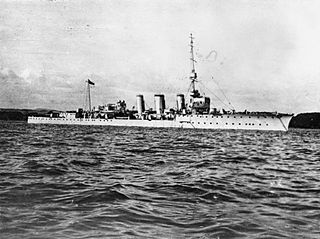
HMSM33 is an M29-class monitor of the Royal Navy. Built in 1915, she saw active service in the Mediterranean during the First World War and in Russia during the Allied Intervention in 1919. She was used subsequently as a mine-laying training ship, fuelling hulk, boom defence workshop and floating office, being renamed HMS Minerva and Hulk C23 during her long life. She passed to Hampshire County Council in the 1980s and was then handed over to the National Museum of the Royal Navy in 2014. A programme of conservation was undertaken to enable her to be opened to the public. HMS M33 is located within Portsmouth Historic Dockyard and opened to visitors on 7 August 2015 following a service of dedication. She is one of only three surviving Royal Navy warships of the First World War and the only surviving Allied ship from the Gallipoli Campaign, the other being the Ottoman minelayer Nusret, preserved in Çanakkale.

HMS Cordelia was a C-class light cruiser built for the Royal Navy during World War I. She was one of six ships of the Caroline sub-class and was completed at the beginning of 1915. The ship was assigned to the 1st and 4th Light Cruiser Squadrons (LCS) of the Grand Fleet for the entire war and played a minor role in the Battle of Jutland in mid-1916. Cordelia spent most of her time on uneventful patrols of the North Sea. She served as a training ship for most of 1919 before she was recommissioned for service with the Atlantic Fleet in 1920. The ship was placed in reserve at the end of 1922 and was sold for scrap in mid-1923.

HMS Humber was a Humber-class monitor of the Royal Navy. Originally built by Vickers for Brazil as Javary, she was purchased by the Royal Navy in 1914 on the outbreak of the First World War along with her sister ships Severn and Mersey.

HMS M29 was a Royal Navy M29-class monitor of the First World War. The ship was constructed by Harland & Wolff, in Belfast and launched on 22 May 1915, she was completed in June 1915. During World War I, the monitor served in the Mediterranean Sea at the Battle of Jaffa in 1917 and took part in operations in support of British and White Russian forces in the White Sea during the Russian Civil War in 1919. The ship was then converted to a minelayer and renamed HMS Medusa in 1925. In 1941 Medusa was converted to a repair and depot ship and was renamed HMS Talbot, then renamed HMS Medway II in 1944. In 1946, the vessel was sold for scrap.

HMS M31 was an M29-class monitor of the Royal Navy.
HMS M32 was an M29-class monitor of the Royal Navy.

The M15 class comprised fourteen monitors of the Royal Navy, all built and launched during 1915.
HMS M28 was a First World War Royal Navy M15-class monitor. She was sunk during the Battle of Imbros in 1918.
HMS M27 was a First World War Royal Navy M15-class monitor. She was also served in the British intervention in Russia in 1919, and was scuttled in the Dvina River on 16 September 1919.
HMS M26 was a First World War Royal Navy M15-class monitor.

HMS M21 was a First World War Royal Navy M15-class monitor. After service in the Mediterranean and the Dover Patrol, she struck a mine off Ostend in January 1918 and sank off Dover.
HMS M20 was a First World War Royal Navy M15-class monitor.
HMS M19 was a First World War Royal Navy M15-class monitor.
HMS M22 was a First World War Royal Navy M15-class monitor. Later converted to a minelayer and renamed HMS Medea, she was wrecked whilst being towed for breaking up on 2 January 1939.
HMS M23 was a First World War Royal Navy M15-class monitor. After service in the Mediterranean and the Dover Patrol, she was also served in the British intervention in Russia in 1919. Converted to the RNVR drillship Claverhouse in 1922, she served in that capacity at "Leith" until 1958.
HMS M24 was a First World War Royal Navy M15-class monitor. After service in the Dover Patrol, she was also served in the British intervention in Russia in 1919. She was sold in mercantile service in 1920.
HMS M18 was a M15-class monitor built for the Royal Navy during the First World War.

HMS M17 was a First World War Royal Navy M15-class monitor.
HMS M16 was a First World War Royal Navy M15-class monitor.

HMS M15 was a First World War Royal Navy M15-class monitor. She was sunk off Gaza by UC-38 on 11 November 1917.







